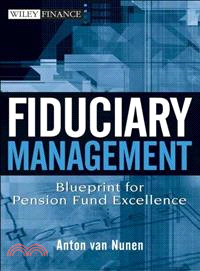| FindBook |
|
有 1 項符合
anton van nunen的圖書 |
 |
$ 2361 | FIDUCIARY MANAGEMENT
作者:Anton Van Nunen 出版社:JOHN WILEY & SONS,LTD 出版日期:2007-11-09 規格: / 274頁  看圖書介紹 看圖書介紹
|
|
|
- 圖書簡介
Fiduciary Management offers an in-depth explanation of every facet of this fast-growing approach to organizing the management of an institutional investment portfolio. Expert author Anton van Nunen begins by outlining the historic shift that has brought this strategy to the attention of the investment community and quickly moves on to illustrate fiduciary management in practice; giving advice in terms of asset-liability modeling and financial markets, constructing portfolios, selecting and overseeing investment managers, benchmarking and performance measurement, and reporting.
- 作者簡介
Anton van Nunen, PhD, has headed Van Nunen & Partners, a consulting firm serving both institutional and individual investors, since 1998. His clients have included a number of major institutional investors in the Netherlands and beyond. Van Nunen has not only spelled out the concepts of fiduciary management, he has also implemented them at such institutions as VGZ-IZA, a major Dutch health insurance company, the Campina Pension Fund, and the Yarden Insurance Company. Van Nunen earned a PhD in economics from Tilburg University, where he went on to spend twelve years as an assistant professor.
- 名人/編輯推薦
"Its key message is that fiduciary management is an idea whose time has come…Nunen provides good case study examples". (Investment & Pensions Europe, April 2008)
- 目次
Foreword.
Preface.
Chapter 1: The Pendulum Swings Back in Asset Management.
The Forces of History.
The Rise of Modern Portfolio Theory.
Support for Shares.
The New Paradigm.
The Rise of Indexing.
Discontent with the Paradigm.
The Need for Fiduciary Managers.
Chapter 2: Pension Plans: The Principal Setting for Fiduciary Management.
The Historical Idea of Pensions.
A Patchwork of Pension Provisions.
Organization and Regulation of the Pension System in several OECD Countries.
Denmark.
France.
Germany.
The Netherlands.
Marking to Market.
Sufficiency Test.
Sweden.
Switzerland.
United Kingdom.
The United States.
Australia.
Similarities and Differences.
Commonalities on the Asset Side.
Chapter 3: The Role of the Fiduciary Manager as Chief Advisor.
The Asset-Liability Study.
Thinking through Risk and Return.
Portfolio Construction.
Selecting and Overseeing Investment Managers.
Measuring and Benchmarking.
Education.
The Trusted Counselor, the Fellow Fiduciary.
Chapter 4: Shaping the Fundamental Investment Policies.
Liability-Driven Investments.
Choosing an Active Investment Policy.
Integrating Active Policy in the Overall Portfolio.
Completion Account as a Necessary Adjunct to Active Policy.
The Fiduciary Platform to Integrate Active Policy in the Overall Investment Portfolio.
A Special Case: Bridging the Duration Gap.
What a Fiduciary Manager’s Report Looks Like.
Chapter 5: Asset-Liability Modeling and the Fiduciary Manager.
The Role of the Fiduciary Manager.
The Asset-Liability Model (ALM).
Policy Instruments Used in Asset-Liability Modeling.
Calculations to Cope with Uncertainty.
The Crucial Role of ALM.
Asset-Liability Modeling in Practice.
Prognosis of Future Reserves without Policy Changes.
Future Financial Situation with Flexible Premium Levels under the Regime of a Fixed Compound Rate.
Future Financial Situation with Flexible Premium Levels under the Regime of Compound Rates Equal to Market Interest Rates.
Future Financial Situation with Changes in Investment Policy.
Policy Changes.
Where Does Fiduciary Management Fit In?
Chapter 6: Fiduciary Management In Practice—Portfolio Construction.
Defining Appropriate Asset Classes.
Hedge Funds: Weighing the "New" Alternative.
Burrowing In: Defining Sub-Allocations.
Thinking about Style.
Apportioning the Fixed Income Portfolio.
Measure for Measure.
Formulating Mandates for Managers.
Chapter 7: Horses For Courses—Selecting And Overseeing Investment Managers.
Creating the Beauty Parade.
Investment Performance.
Investment Process and Philosophy.
Investment People.
Operational Risk.
Managing the Beauty Parade.
Managing the Transition.
Overseeing the Managers.
Chapter 8: Performance Measurement and Benchmarking.
Why Has Benchmarking Grown More Important?
The Use of Different Types of Benchmarks.
Liability-Driven Benchmarks.
Strategic Benchmarks.
Fixed Income.
Equities.
Real Estate.
Detailed Benchmarks in the Context of Active Investment Policy.
Active Overlay Management.
Rebalancing.
Measurement of Active Policy.
Chapter 9: The Fiduciary Manager Experience in the Netherlands and Beyond.
Changes in Investment Policy.
Changes in the Role of a Fund’s Investment Committee.
Changes in the Breadth and Depth of Discussions with Asset Managers.
Changes in the Communication Process.
Changes in the Level and Structure of Costs.
Changes in the Importance of the Custodian.
Overseeing the Fiduciary.
Future Developments of the Market for Fiduciary Services.
Beyond the Netherlands.
Fiduciary Management Plus.
Chapter 10: Summing Up Fiduciary Management: What It Is and Is Not.
Goals, Policy, and Responsibilities.
Fiduciary Management Can Enhance Productivity.
What Fiduciary Management Is Not: A Simplification.
Comparisons with Other Investment Management Models.
The Concept’s Claims.
Appendix: Suppliers of Fiduciary Services.
Notes.
Bibliography.
Index.
|











